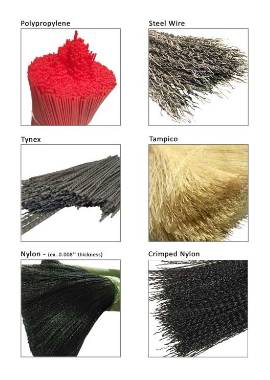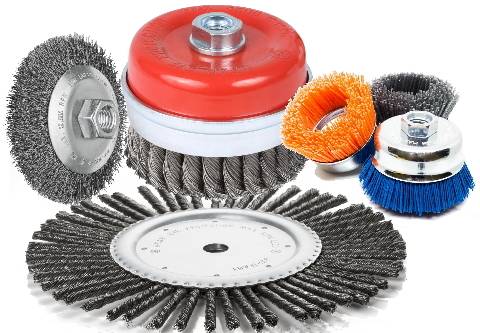Support
On this page, we present technical information about filament, brush type, applications.
Practical background, choice of materials and functionality are the basis for innovative new product. Our research and development departments have long experience and our technical application engineers bring their knowledge directly in your company to find solutions.
If you need catalogues, leaflets and brochures, PDF, documents, video and presentation about industrial and professional brushes, contact us for the latest version.
Filament
Steel
- Pull strength: 180-200 kg/mm2
- High removal capacity.
- Suitable for twisted knot wire brushes: 0,50 and 0,80 mm wires.
Stainless steel
- Pull strength: 160-180 kg/mm2.
- AISI 304 (W.-Nr 1.4301) and AISI 302 (W-Nr. 1.4310).
- Available with: 0,20, 0,30, 0,40 and 0,50mm wires..
Brass
- Pull strength of: 80-95 kg/mm2.
- Corrosion resistant.
- Suitable for work that requires a fine finish.
- Anti spark wire.
- Available with: 0,30 and 0,40 mm wires.
Abrasive nylon
It is made up of polyamide filaments (PA 6), impregnated with granular abrasive. With 2 types of filaments:
- Nylon 6-12: with silicon carbide grains. For Industrial aplications. Available in 120,180 and 320 grains.
- Nylon 6: with aluminium oxide grains. For DIY. Grain 80.
Brush Type
Miniature Brushes
Polishing Brushes
Bottle Brush
Spiral Brush
Pipe Brush
Power Brush
Wire Brush (Industrial Wire Brush)
Wire brushes are brushes made with metal bristles. Metal manufacturers and fabricators rely on metal wire brushes for deburring, surface brushing, and parts cleaning. Metal wire brushes, like the steel wire brush, can be hand-held or machine-operated; hand-held metal wire brushes tend to be used for heavy-duty scrubbing, and machine-operated metal wire brushes are used to machine or treat a surface. Brass brushes, made from brass, which is a softer wire than stainless steel. Brass brushes are perfect for use in applications that require burnishing, polishing, non-sparking static spark removal and some deburring and material removal.
Wheel Cleaning Brush
Wire Wheel Brush
Twisted-in-Wire Brush
Twisted-in-wire brushes are smaller brushes that are basically pieces of doubled-over wire with bristle material inserted between the fold of the wire stem. These hand-held or machine-powered brushes are smaller than the wheel brushes, so they are useful to reach smaller areas that need to be deburred or finished.
Tube Brush
Cup Brush
Brush Selection
The criteria for choosing the most suitable brush for each application are the following:
- The work to be carried out.
- The type of surface which is to be brushed.
- The machine with which the work will be done and its speed
To choose the type of material, wire or abrasive nylon:
- The material of the surface to be brushed.
- The type of finish desired
- The machine with which the work will be done and its speed
Furthermore, other characteristics must be taken into account:
- Brushing is more efficient at greater brush diameters. (Do not exceed 175 mm. in diameter in portable machines of 6000 r.p.m. maximum.)
- Shorter trim lengths result in more aggressive brushing and longer trim lengths offer better flexibility for irregular surfaces.
Max RPM
Max RPM (Surface speed) is a decisive factor in achieving optimum performance from a brush.Please choose the appropriate surface speed on the basis of the materials of the surface,required effects and the power applid.As a general guide,we recommend the following surface speeds when working on the materials listed.Please note: the operating speed should never exceed the maximum RPM ratings for each brush as shown in this catalogue.
Brushes with Crimped Wire
Steel-approx.30m/sec.Non-ferrous metals.18-20m/sec.Plastic-approx.15m/sec.Brushes whith Abrasive Filaments.15m/sec.
All operators and other personnel in areas where brushes are being used must wear safety goggles or face shields.
Copyright © 2017. Aiya Technology All rights reserved. ------ Sitemap









